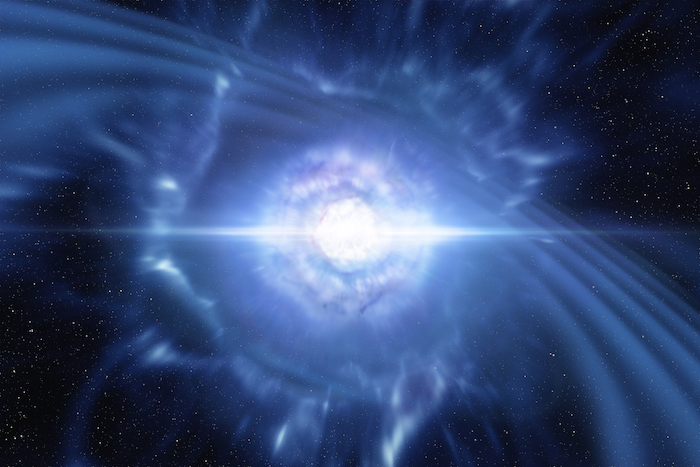MEDIA CONTACTS:
Jamie Rogers: JamieRogers gwu [dot] edu (JamieRogers[at]gwu[dot]edu), 202-994-3087
gwu [dot] edu (JamieRogers[at]gwu[dot]edu), 202-994-3087
Brett Zongker: bzongker gwu [dot] edu (bzongker[at]gwu[dot]edu), 202-994-6466
gwu [dot] edu (bzongker[at]gwu[dot]edu), 202-994-6466
WASHINGTON (Oct. 16, 2017) —Three astrophysicists from the George Washington University are part of a global group of scientists who collaborated on identification and study of the first confirmed observation of two merging neutron stars, a so-called kilonova. The existence of a kilonova—an explosive event roughly 1,000 times brighter than a nova—had long been suggested but was never definitively witnessed until now.
“For the first time ever, we have detected both gravitational waves and electromagnetic radiation at the same time from a single source,” said Chryssa Kouveliotou, professor of physics in GW’s Columbian College of Arts and Sciences and head of the GW Astrophysics group. “With these observations, we put the astrophysical context to the gravitational waves. This is a monumental result - the result of the decade.”
The merger of two neutron stars was predicted to generate both gravitational waves and emit electromagnetic radiation at various wavelengths. Researchers also suspected that these mergers are the source of mysterious short gamma-ray bursts. The recent observations confirmed those predictions.
On Aug. 17, the Advanced Laser Interferometer Gravitational-Wave Observatory (LIGO) in the United States and the Advanced Virgo Interferometer in Italy alerted scientists to a gravitational wave event. Two orbiting space observatories, the European Space Agency’s INTErnational Gamma Ray Astrophysics Laboratory (INTEGRAL) and NASA’s Fermi Gamma-ray Space Telescope detected a short gamma-ray burst coming from the same area of the sky as the gravitational wave event.
In the days following the initial detection, scientists aimed their instruments at the object, located some 130 million light-years away in the constellation Hydra. The effort included the European Southern Observatory’s telescopes in Chile, Gemini South and the Cerro Tololo Inter-American Observatory (CTIO) and others, which detected the light from this gravitational wave event. Together these observations confirm that a kilonova had, in fact, been detected.
Gamma-ray bursts are the most powerful, brightest explosions in the universe. These short, transient events can last a few seconds or minutes, providing information about the formation and expansion of our universe. Dr. Kouveliotou, a leading expert on gamma ray bursts, worked closely with the research group led by Elena Pian of Istituto Nazionale di Astrofisica in Italy to study the optical and infrared electromagnetic radiation emitted from the merger. Each element in the universe emits a unique spectrum, so this data can help researchers determine how and where rare elements on Earth originate. The work published in Nature by Dr. Pian, Dr. Kouveliotou and others, confirms that neutron-star mergers are major cosmic production sites of heavy elements such as gold, platinum and lanthanides.
Other members of the GW Astrophysics group studied different aspects of the kilonova. Alexander van der Horst, an assistant professor of physics in CCAS, and Dr. Kouveliotou co-authored a paper that examined the polarimetry of the light emitted by the neutron-star merger. By studying the light emitted by the event in this way, scientists are learning more about how the light is produced.
“Polarimetry is a very powerful tool to determine properties of the source producing the light that we observe,” said Dr. van der Horst. “While this particular event did not have a strong polarimetry signal, future observations will be able to pin down the structure of the source with such observations.”
Dr. van der Horst is also leading the science team working on OCTOCAM, a new instrument being built at the Gemini South Observatory that will allow researchers to do in-depth studies on objects of interest such as kilonovae once they are detected. OCTOCAM is scheduled for completion by the end of 2021.
Bethany Cobb Kung, an associate professor of honors and physics in GW’s Columbian College of Arts and Sciences, used a telescope at CTIO to observe the infrared glow from the kilonova over a course of 10 nights.
Dr. Cobb Kung was a part of a team of astronomers led by California Institute of Technology’s Mansi Kasliwal. The team along with another led by Harvard University’s Edo Berger studied the composition of the material released by the merging of the two stars, further confirming that a kilonova had been witnessed.
“Near infrared observations of the event were absolutely critical,” said Dr. Cobb Kung, “because the optical light from the source faded away very quickly, and one of the key signatures of a kilonova is its behavior at infrared wavelengths.”
Drs. Cobb Kung, Kouveliotou and van der Horst are also among the authors of another paper published in Astrophysical Journal, which describes in detail the timeline of this discovery. These three GW astrophysicists plan to continue to study gravitational wave astrophysics in a new era that has started with this extraordinary event.
The findings by GW researchers were published Monday in the following journals:
- Nature: “Spectroscopic identification of r-process nucleosynthesis in a double neutron star merger”
- Nature Astronomy: "The Unpolarized Macronova Associated with the Gravitational Wave Event GW170817"
- Science: "Illuminating Gravitational Waves: A Concordant Picture of Photons from a Neutron Star Merger"
- Astrophysical Journal: "Multi-Messenger Observations of a Binary Neutron Star Merger"
Images Available Upon Request
-GW-


